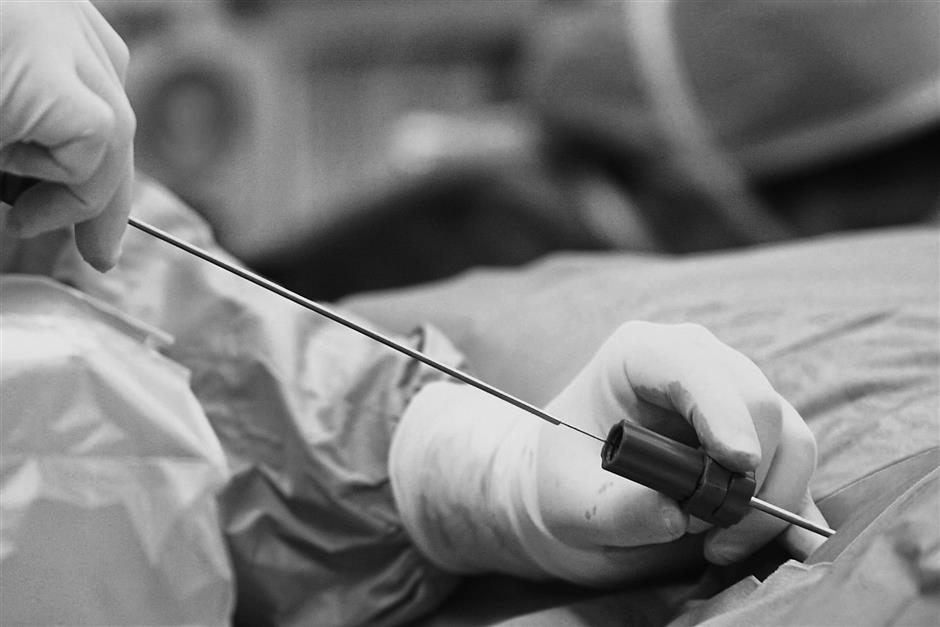
Surgeries can be a stressful experience for both the patient undergoing the procedure and the surgeon wielding the instruments.
Sometimes, it can be traumatic if the surgery is a major one that involves weeks, or even months, of recovery.
The current trend is to make major surgeries as minimally invasive as possible.
This includes minimally invasive coronary artery bypass surgeries, where recovery time is shorter, smaller incisions are made and cost is lowered as patients spend less time at the hospital.
However, carrying out such a surgery can be complicated and it takes more than the competency of the surgeon to make it work.
National Heart Institute (better known by its Malay acronym IJN) senior consultant cardiothoracic surgeon and Private Healthcare Division operation head Datuk Dr Mohamed Ezani Md Taib says that this surgery, which IJN started offering 18 months ago, is more challenging.
 As not every bypass is the same, a surgeon needs lots of experience to know how to deal with the unexpected during a coronary bypass surgery, according to Dr Mohamed Ezani. — IJN
As not every bypass is the same, a surgeon needs lots of experience to know how to deal with the unexpected during a coronary bypass surgery, according to Dr Mohamed Ezani. — IJN
One reason is because the incision being made is much smaller compared to the regular surgery.
“In a normal bypass, you cut the sternum with a saw, while with this, we go between the ribs,” he explains.
“You don’t cut bones. You cut muscles between the ribs to get to the heart. It is a smaller view compared to the normal way.
“The heart is still beating. It is like going to the workshop to repair a car while the engine is running.”
Because of the complexity involved, he says that not all hospitals can carry out the procedure.
A hospital is deemed capable of handling such a surgery if they have a large volume of cases that have had good and safe outcomes, aside from being staffed with experienced personnel from the top to the bottom of the organisation.
Such a hospital should also handle a wide range of case types to ensure that the surgeons and their teams can handle situations such as differing blood vessel size or calcified blood vessels.
“Not every bypass is the same,” says Dr Mohamed Ezani.
“When you have seen and done enough surgeries, you can deal with it.
“If you don’t and suddenly see something out of the norm, you will be wondering what to do.”
The surgeon also needs to rewire his brain to work in a mirror image situation, as he is looking at the organs via a television screen, rather than directly at them.
Minimally-invasive surgery also requires handling longer equipment, which affects how one carries out the surgery.
The surgeon has to be able to carry out beating heart surgeries successfully.
“Your stress levels go through the roof. I always take an antacid before this surgery.
“It doesn’t tolerate mistakes. One small mistake and the whole thing is a disaster,” he says.
Team work is especially important as the surgeon’s attention will be on operating through a small hole.
Dr Mohamed Ezani likens it to changing tyres on a Formula 1 car during a pit stop.
“I show the F1 video and tell the team, ‘This is how we need to work. As a driver, I cannot be telling you which tyre to change.’
“It has to work like telepathy, compared to a normal surgery where you have a big space to work on,” he says.
He adds that the hospital also has to buy into the idea and provide the necessary equipment and training, citing that he and an anaesthesiologist were sent to the United States and Germany respectively for additional training.
Visiting fellows to IJN are also provided the necessary training.
Improved technology, such as improved equipment and lighting, has also contributed to the availability of the surgery.
Currently, Dr Mohamed Ezani is the only surgeon at IJN conducting such surgeries, with a total of 37 over the past 18 months.
Besides IJN, this type of surgery is also carried out at UiTM Private Specialist Centre, Sungai Buloh, and University Malaya Medical Centre, Petaling Jaya – both in Selangor.
Advantageous for patients

Minimally-invasive surgery uses long, thin instruments that can be put in through small cuts on the body, as can be seen in this filepic.
Dr Mohamed Ezani says that for many patients, such a surgery is a major psychological win, as they do not feel like their chest has been pried wide open with the surgeon’s hands inside them.
“So, for them, it is not so scary,” he says, adding that sometimes though, the surgery has to be converted into a normal bypass if it is found that the vessels are unsuitable for the minimally-invasive surgery.
“The advantage is the smaller incision and they experience less pain.
“Their recovery is faster. Some can go back on the third day. This is compared to seven to 10 days (for the open surgery),” he says.
Dr Mohamed Ezani adds that the most important aspect for the patient is that they can resume their normal routine, including going back to work, earlier.
While patients who undergo a normal bypass surgery are typically given medical leave of six weeks or more, those who have a minimally-invasive coronary artery bypass surgery only need three weeks of leave.
Cost and risk of infection for the patient is also lower as their hospital stay is shorter, while those using insurance would not have their coverage impacted as much.
“They don’t have to worry about lifting heavy things or driving.
“Of course, there will be some pain, but there is no broken bone (a cut sternum), which takes time to heal,” he says.
He adds that some patients within the working age group are willing to forego medical treatment as they do not want to risk losing their jobs.
“It is very sad. You are dangling your life because of work.
“But if you have no work, then there is no money for food for the kids. But if you don’t do it, you die,” he says.
With this surgery, the employer also does not have to face the prospect of having their employee out of work for a long period of time.
However, not all patients are suited to undergo minimally-invasive coronary artery bypass surgery.
Dr Mohamed Ezani says that a patient is unsuited to undergo the surgery if they have valve problems, or small or diffused coronary vessels.
Those with bad lung diseases are also unable to have this surgery.
This is because the left lung will not be ventilated (i.e. will not receive oxygen) during surgery.
“So, patients who cannot tolerate single lung ventilation will be excluded from this surgery,” he says.
Patient stories
Lau Ka Kin was referred to IJN for the surgery from Sibu, Sarawak, after it was found that his heart was 70% blocked.
“I feel much better now although there is a bit of pain.
“Before the operation, I felt my heart was beating very fast and irregularly. That’s what led me to see the doctor,” he says, adding that he was a non-smoker and used to play badminton.
“After the surgery, I stayed overnight at the ICU (intensive care unit).
“Now, they have me doing exercises like lifting weights.”
Another patient, Abu Bakar Othman, 57, from Kedah, says he sought medical treatment in 2015 at the Sultanah Bahiyah Hospital in Alor Setar after he had difficulties breathing.
He was put on medication when doctors found that his heart was 60% blocked.
Abu Bakar underwent the minimally-invasive procedure at IJN after being referred by his doctors in Kedah.
“I cannot wait to be discharged,” he says.
This article is brought to you by IJN.


 GP ACCESS
GP ACCESS